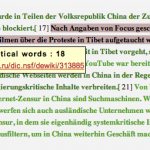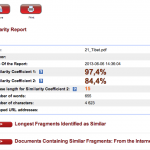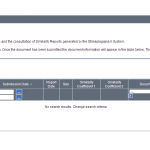Description | Pros & Cons | Report | Usability | Summary | Screenshots | Links
Software Profile
| ID | S13-18 |
| Product | Strike Plagiarism |
| Company | Plagiat.pl Sp. z o.o. Sebastian Kawczynski, PhD E-Mail: skawczynski@strikeplagiarism.com ul. Wróbla 8 02-736 Warsaw |
| Web-Site | http://www.plagiat.pl |
| Software-Type | Online |
| Pricing | 2.46 € for 20,000 characters |
| Testdate | 6 June 2013 |
Description
The Polish plagiarism detection software StrikePlagiarism has been tested in all of the last tests. Even though it has not ranked high, it has been improving so it was also included in the current test.
Pros & Cons
Working with StrikePlagiarism in general takes a lot of time for the user. There are multiple checkboxes and text fields without clear descriptions which have to be filled in for each document that is to be examined. The overview of the testcases can be exported in EXCEL-format, which can be useful for preparing statistics on the cases submitted. The documents submitted can contain up to 500,000 characters each, checking 20,000 characters cost the user 2.46 €. StrikePlagiarism has recently rolled out a new version of their system which has improved design and usability. This version was tested this year.
Report
It might be confusing for users that StrikePlagiarism gives two different percentages of plagiarism for each document. These differ in particular by the number of sequential identical words that are rated as plagiarism. In most of the cases, the first method gives a higher percentage, which is an indicator that the word count is smaller. For rating the system, the second percentage was used in this test. It is unclear, however, exactly how many words are counted each time, because the documentation states 15 words in one place and 25 in the other.
On the one hand, StrikePlagiarism finds many sources, but on the other hand it does not find the complete amount of plagiarism in the texts. It was able to identify the source for the Hebrew testcase and it was able to find plagiarism in the large documents. But the system is not able to find plagiarisms from Google Books.
The report is comprehensible in most cases, but can only be downloaded in HTML. Nevertheless, the system fails in some cases for example it reported the Japanese Wikipedia page as the source for the Eyjafjällajökul test case. One problem of the system is that it finds a lot of Wikipedia copies instead of the original source.
Usability
The design of the system is user-friendly in general, but could be improved in terms of visual design. It is necessary to understand English in order to navigate the site, because the German translation is not consistent. It is annoying for the user that the system takes a good bit of time for the analysis of the documents and that it is not possible to upload multiple documents. The user has to upload one file at the time and can submit up to five papers at the same time for checking. It is then not possible to check any other documents until these are finished.
Summary
StrikePlagiarism has improved their effectiveness compared to the previous tests of the software. It was able to find many of the sources, but still not all of them and not completely. However, a fair amount of time must be invested if a number of documents are to be tested at the same time.
Screenshots
- For the testcase Eyjafjallajökull the Japanese Wikipedia was listed instead of the English Wikipedia.
- Report view in StrikePlagiarism.
- A similarity report in StrikePlagiarism.
- Report overview of StrikePlagiarism.
Links




